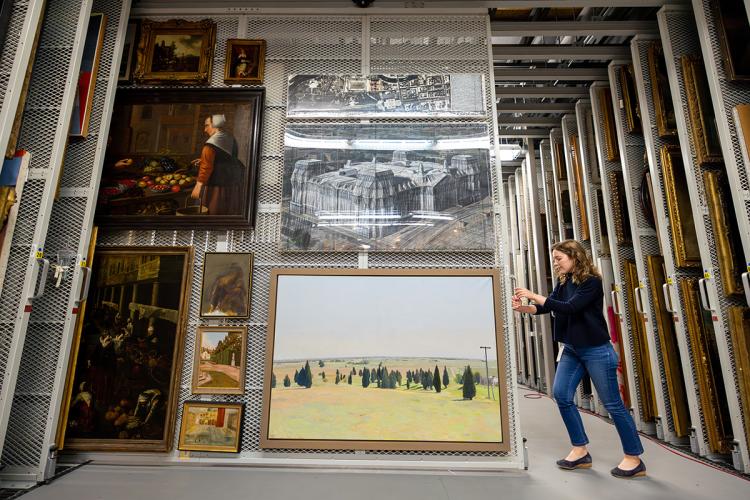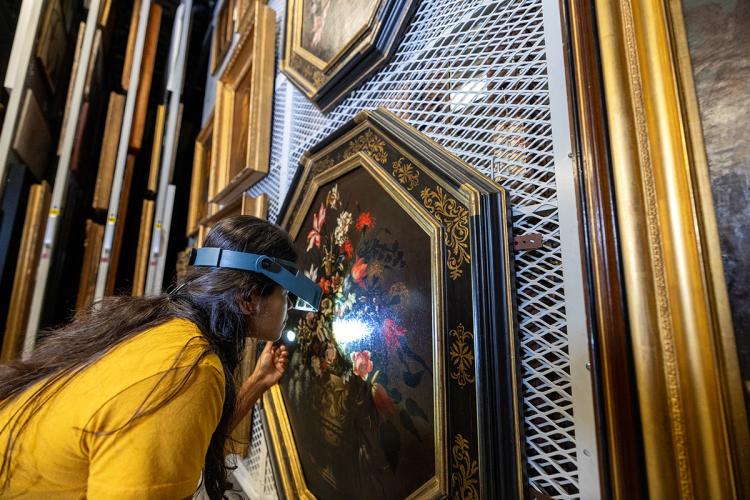Visitors to Yale’s galleries, libraries, and museums can see thousands of objects on display, such as ancient maps, celebrated paintings, and historic textiles. But these institutions hold far more objects than they have space to exhibit, meaning that most of Yale’s historic collections are hidden away.
For the last two decades, many works of art belonging to the Yale University Art Gallery have been housed and cared for at Yale’s Library Shelving Facility in Hamden, Connecticut, a few miles from campus.

“Any time a curator wants to access an object here, they have to submit a work order, and then art handlers consult the data base to locate the object, use powered industrial vehicles to retrieve the item, and unpack it for viewing in a curatorial work room,” says Jeffrey Yoshimine, deputy director for exhibition and collection management at Yale University Art Gallery. “It’s a storage system that is ideal for space-efficiency, but far from ideal for access.”
Direct Access for Teaching & Research
Now, with support from Ted Shen ’66 and Mary Jo Shen, more than 18,000 objects are being relocated from the Hamden facility to the Collection Studies Center on Yale’s West Campus.
“Housing these works of art right across from our object-study classrooms is going to make a huge difference in the way we teach from the collections,” Yoshimine says. “This world-class collection, spanning hundreds of years of global artistic production, will be accessible by simply taking a painting off a rack and bringing it across a hallway to where students are assembled.”
Ted and Mary Jo Shen say they chose to support the move to inspire collaboration and accessibility.
“This West Campus initiative importantly supports the gallery’s mission to be a leading force among teaching museums through proactive use and sharing of its extraordinary collections both within the Yale community and with the outside world,” Ted Shen says. “This move will facilitate not only increased access to the Yale University Art Gallery collections, but also increased collaboration with Yale’s other collecting institutions as they also utilize the Collection Studies Center for their own storage needs.”
A Historic Move
Twenty years ago, George Hagerty was working to move 60,000 objects to make room for a new wing at Boston’s Museum of Fine Arts. He came to New Haven to learn about the groundbreaking systems created by Yale in the early aughts. Hagerty says that today, the methods designed at Yale have been adopted almost universally as the most cost-effective and safe way to move precious objects domestically.
“It’s a full-circle moment for me to be back here working at Yale to build upon the systems designed for the previous move,” says Hagerty, who is now director of facilities at the gallery. “There is no institution better at caring for these precious objects through a local relocation.”

Yale University Art Gallery Director Stephanie Wiles notes that beyond enabling a relocation of objects, the Shens’ gift supports the gallery’s overall mission.
“We are actively planning how these new spaces will advance the Art Gallery's research and teaching aspirations,” Wiles says. “It was exciting that Ted and Mary Jo immediately appreciated that their gift would help spark new conversations about how we activate collections intellectually and advance interdisciplinary research. We are so grateful for this early foundational support.”
Under One Roof
Historically, collections at institutions like the Peabody Museum, Beinecke Rare Book and Manuscript Library, Yale University Art Gallery, and the Yale Center for British Art have been siloed, limiting research and collaboration.
“Now, with objects from those collections under one roof at the Collection Studies Center at West Campus, we are breaking down walls between institutions to allow for more seamless access to collections for all,” Yoshimine says. “This is the first step toward a more open operating model in terms of collection storage, bringing material from all over Yale into shared spaces to be stored, conserved and studied.”
